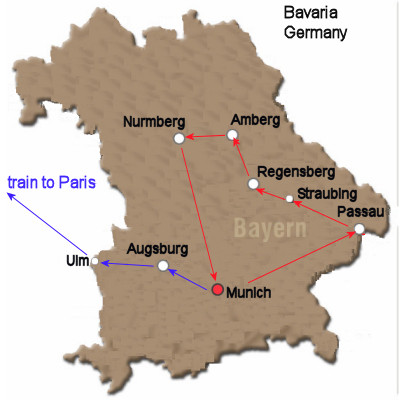
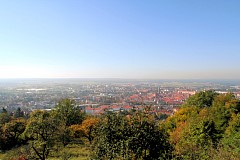
|
Monday, September 24, 2007.
Amberg, Bavaria
Located in the Upper Palatinate, the town was first mentioned
in 1034 under the name Ammenberg.
It became an important trading center in the Middle Ages, exporting mainly
iron ore, iron products, and coal. In 1628 Amberg became part of the
electorate of Bavaria. The inhabitants were given the choice: return
to Catholicism or leave the town forever. Many families left the
town and fled to the Free Imperial Cities of Regensburg and Nuremberg.
|
|
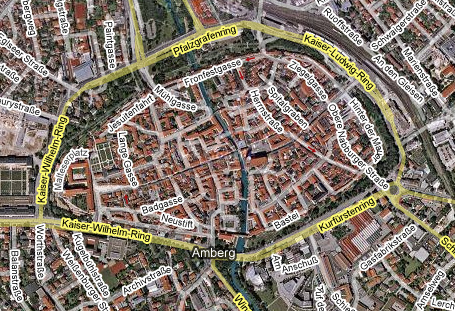
Here you can see the modern streets that delineate the old fortifications, and the
river Vils that cuts across the mediaeval city. Fortified gates over the river
had bars that could be lowered to keep enemies out.
While here I learned the Bavarian colloquialism "Passt Scho". Pronounced "Bossed
show" leaving the mouth open and round on the ending syllable, it means "that fits",
or "I don't have a problem with it".
|
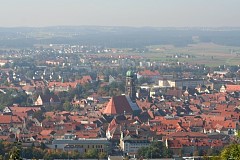
Amberg is nestled in the valley of the Vils river, which flows through the old town.
Christal is showing me the town. Later Josef will join us as we take the train to
Nuremburg. We are currently at the local pilgrimage church on a hill 1621 feet high,
The old medieval and Baroque town is still ringed by part of it's city walls.
The large church is the late-Gothic Pfarrkirche St Martins.
|
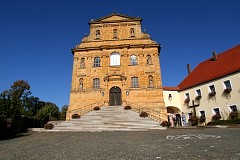
This is the baroque Franciscan monastery on the Mariahilfberg hill above the city.
The Mariahilfberg (literally: Maria-Help-Mount) was given its name during the
bubonic plague in the Thirty Years' War in 1633/4 when the locals beseeched
the Virgin Mary to rid them of the plague.
They had promised if the plague
epidemic in Amberg would go away, they would build a church on top
of the hill.
However, there were so many pilgrims visiting the church, so
that they soon had to build a larger church. In 1696/98 they
began demolishing the old chapel and started to build a new
church. The church was structurally completed in 1699. The
roof was put on in 1703. In 1702 Giovanni Battista Carlone
(1642-1721) did the stucco work. It was interrupted by the
Spanish war of succession and was completed in 1717.
|
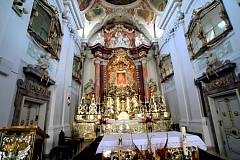
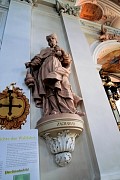
The picture on the left of the interior is blurred. It occurs to me from taking photographs
on this trip that I could do a much better job of taking pictures of church interiors
if I used a tripod and the camera's exposure priority setting. It would, of course,
take much longer to setup etc., so as it is, it is what it is.
|
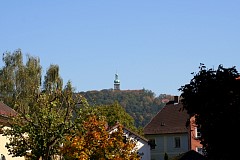
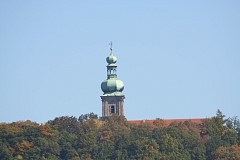
Taken later in the day from the town looking back up Mariahilfberg, these two photos show
the early fall foliage and the spire at the back of the church on the hill which doesn't
appear in the frontal view above.
|
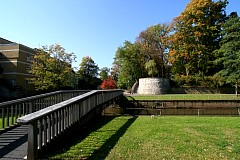
We approach the moat and one of the turrets from the old city wall. The city was never
breached during siege, and that's one reason why the city wall remained for so long.
The line of the old wall is now marked by a
succession of parks and gardens.
|
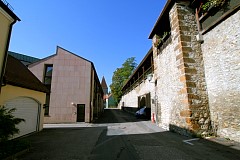
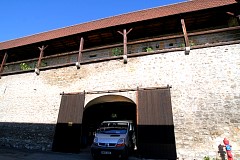
Here is a section of the city wall that has been turned into
garages for the locals. Note the battlements atop the wall. They provided cover
for the defenders and allowed them to quickly move along the wall to move to threatened
areas.
|
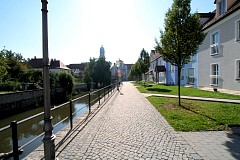
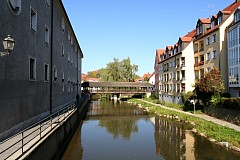
We are making our way beside the river to the old city center.
|
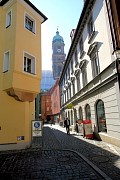
Once again, narrow medieval streets ...
|
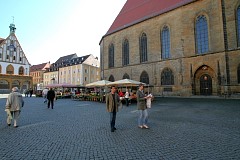
Here in the Marktplatz (Market Square), you can see (far left) the Gothic Town Hall
(first built at this site in 1358) and at the right a wall of the late-Gothic
St Martins minor Basilica.
St Martins (1421-83) parish church in Amberg is the most important
Gothic church in the Upper Palatinate after Regensburg Cathedral. The 91m/299ft
high west tower was built in 1534. 1544 it became a Protestant church.
After the counter-reformation it became Catholic again.
|
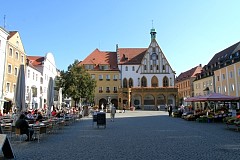
A better view of the marketplace and the town hall.
Today's city hall is still on the same place that the first city hall was
in the 13th century. In former times even executions took place in front of the city hall.
|
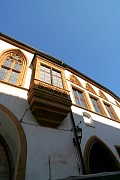
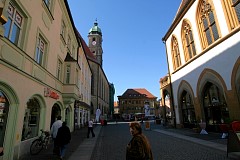
This window along the street caught my eye. The building straight ahead in the picture
to the right of this is empty for some reason - I think it was lately used as a bank.
|
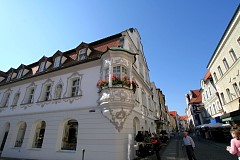
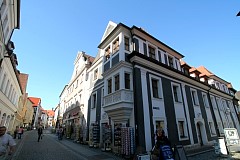
The left-most picture is the Frenzl House with it's beautiful oriel.
|
|
I don't have a picture to go along with this item, but
Amberg is one of the late medieval town that offered a Eh'häusl (wedding house).
By city law a couple could not get married unless they owned a home.
The law did not say how big the house had to be, so one particular man
built a very tiny home between two existing homes so he could get married,
These days, Amberg's marriage house is the smallest hotel in Europe,
able to accommodate just two people.
|
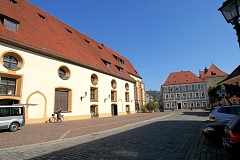
I don't think this woman is waving at me, but let's pretend she is. I thought both
buildings displayed interesting design.
|
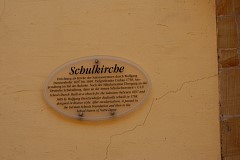
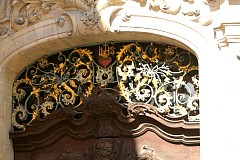
Can you interpret German? Look closely, I think you can. The right-most picture shows
the camera trying it's best to reconcile dark and light in the same shot.
|
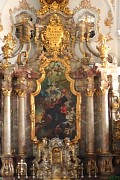
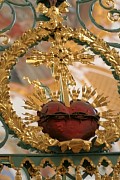
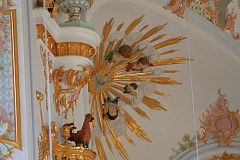
Again, bad church interior photography by me, included to try and complete the scene of
this Rococo style church. Note
the chicken (?) in the right-most picture.
|
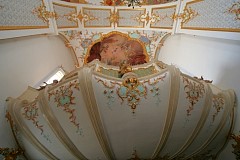
The word Rococo is seen as a combination of the French rocaille,
or shell, and the Italian barocco, or Baroque style. Due to Rococo
love of shell-like curves and focus on decorative arts, some critics
used the term to derogatively imply that the style was frivolous or
merely fashion; interestingly, when the term was first used in English
in about 1836, it was a colloquialism meaning "old-fashioned". However,
since the mid 19th century, the term has been accepted by art historians.
While there is still some debate about the historical significance of the
style to art in general, Rococo is now widely recognized as a major period
in the development of European art. Note that this church structure holding
the organ is literally a sea shell.
|
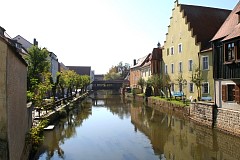
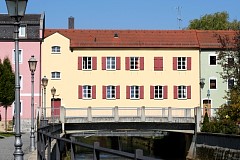
I really like the right-most picture of the house spanning the river.
|
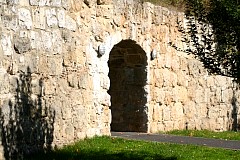
A last picture of Amberg's medieval wall as we exit the city.
Now Josef is going to join us and we are going to catch the train to Nuremburg.
|